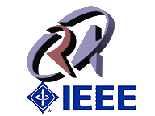
 |
ROBOTICS AND AUTOMATION involves designing intelligent machines which can do work too dirty, too dangerous, too precise or too tedious for humans. Intelligent machines are used in defense, space and underwater exploration, service industries, disaster relief, manufacturing and assembly, medicine, entertainment and all kinds of mechanical motion devices which can help and support humans or their wellbeing.. The first robotic lawnmowers and vacuum cleaners are now marketed for home use! |
|
Members of the IEEE Robotics and Automation Society are the people who drive this remarkable technology. IEEE Robotics and Automation Magazine is a unique technology publication, which aspires to be both peer-reviewed readable and substantive. Many of our feature articles come out of the foremost R&D labs in the world, but are written with an eye to helping robotics and automation industry professionals understand how new concepts in robotics and automation may be applied to real-world systems. Special issues on topics such as panoramic robotics and intelligent transportation systems provide an in-depth look at exciting new topics. In 2005 we also plan to increase our coverage of education, with topics relating both to teaching robotics and automation concepts to engineering students and the increasing number of ways robotics is used to teach fundamental concepts of math, physics and problem solving to students at all levels. RAM complements its sister publications, the IEEE Transactions on Robotics (formerly titled IEEE Transactions on Robotics and Automation) and the new (2004)IEEE Transactions on Automation Science and Engineering. Like other IEEE journals, the widely respected Transactions publish the basic mathematical and engineering theoretical and experimental findings, which are crucial to any real technological progress. The Magazine brings these results to the practicing engineer. Types of submissions: The type of submissions include regular papers, a contribution for an announced special issue, a survey paper which could be used for an educational department, a correspondence item in which you can exchange your opinion with the members of the society and the EiC, and others which are available in the submission page. For a special issue, choose the appropriate Guest editor in the submission page. In all other cases submit to the Editor in Chief. Submissions requirements: The submitted paper should be prepared as a pdf file for the review. No specific format is required. If the paper will be accepted certain formats are required and information can be found HERE. Required length: Depending on the type of article different lengths are accepted. The nominal length is four pages for a non-technical contribution, three pages for a practitioner corner contribution and eight pages for a technical feature. Notice that the paper will be re-typeset and therefore it will be difficult to estimate its length beforehand. As an indication, a “typical” eight page magazine article contains 4000–5000 words (including ten references) plus five equations and seven figures. Be aware that mandatory page charges of $250 per excess page per articles will be applicable. Format: The paper should be prepared in pdf for the review phase and does not require a specific format. If accepted will be reformatted by IEEE but the manuscripts and the artworks should be provided separately and the file formats are mandatory. The details can be found HERE. |